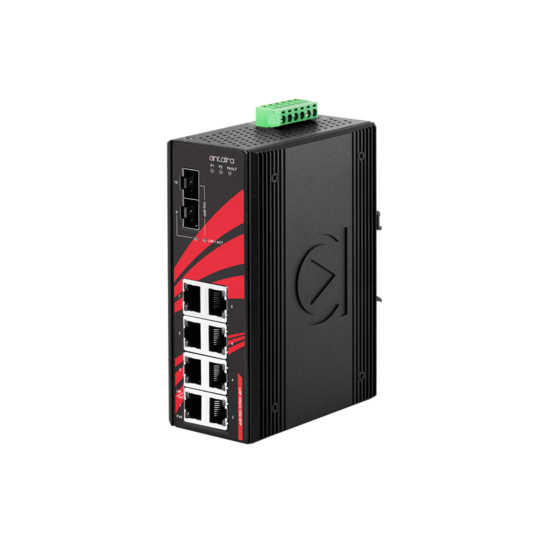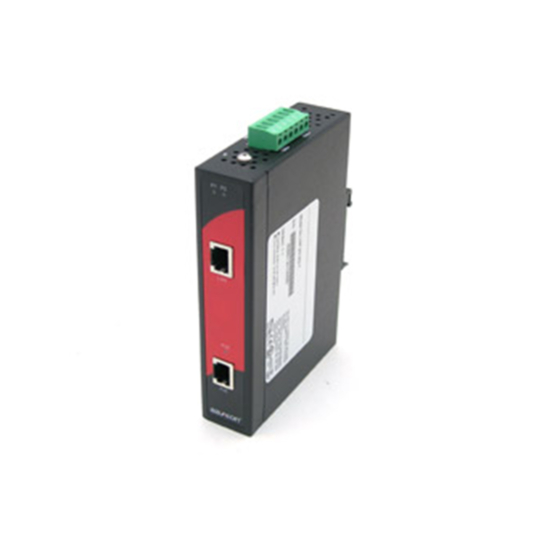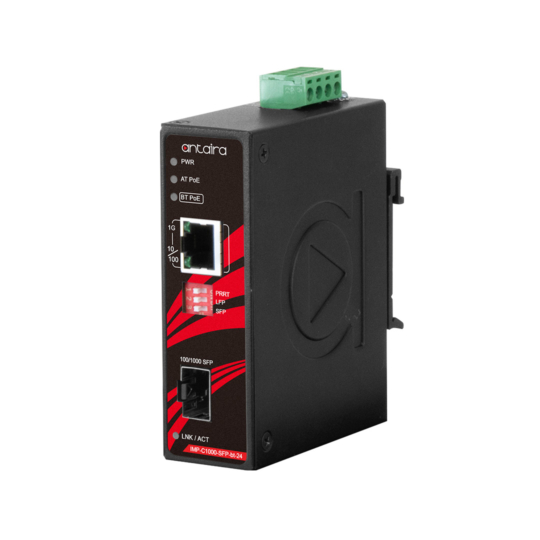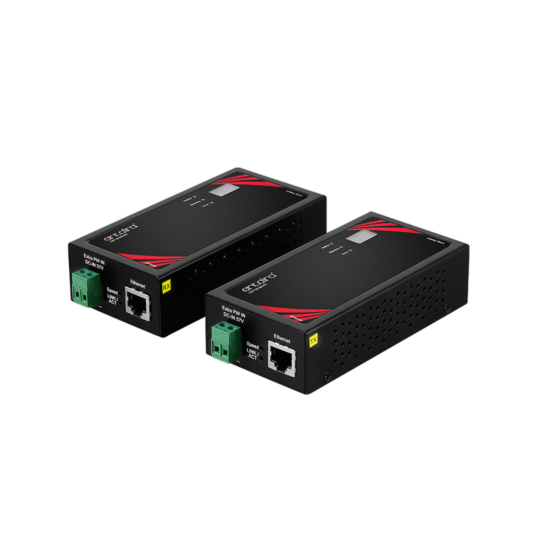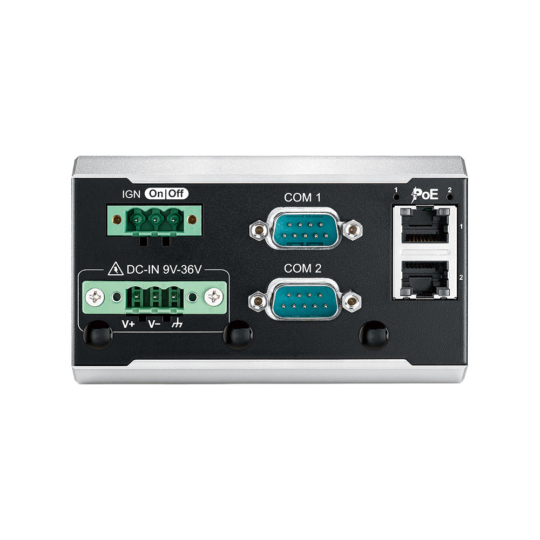A Guide to Industrial Power over Ethernet
Power over Ethernet (PoE) is a technology that utilizes an RJ-45 or M12 port to enable data transmissions up to 100 meters at speeds of 10mbps, 100mbps, and 1,000mbps. Not only does the PoE port provide the same functions as a standard Ethernet port, it is capable of supplying electricity over the same cable. The technology is also becoming increasingly popular in industrial applications, where it can be used to power sensors and other devices in difficult-to-reach or hazardous locations.
A wide range of industrial PoE switches are available and defined by IEEE standards; 802.3af (PoE), 802.3at (PoE+), and 802.3bt (PoE++). Most PoE ports provide up to 15 watts of power, which is enough to power most small devices. PoE+ ports provide up to 30 watts of power, which is enough to power larger devices or multiple smaller devices. PoE++ ports provide up to 60 watts of power, which is enough to power extremely large devices or multiple smaller devices. PoE+ switches are able to work with the standard PoE, and they offer more power than the regular PoE (30 watts instead of 15 watts). This creates a situation where all products from different companies can work together, and there is a wider selection of products available.
How Does PoE Work?
Power over Ethernet enables the Ethernet cable to deliver both power and data to connected devices. This is accomplished by using twisted pairs within the Ethernet cable to carry both power and data.
The most common type of PoE is 802.3af, which can deliver up to 15.4W of power per port. This system employs two twisted pairs of wires to send information, and the other two pairs are utilized to send power. There are also higher-power variants of PoE, such as 802.3at and 802.3bt, which can deliver up to 30W and 60W of power per port, respectively. For the 802.3at and 802.3bt standards, electrical power and information are transmitted over all four pairs of wires, yet they don’t interfere with each other. This is because the electrical current has a much lower frequency than the data signals, which range from 10 million to 100 million hertz.
In order to take advantage of PoE, network devices must be equipped with a PoE enabled Ethernet interface. Most modern Ethernet switches include PoE support, as do many IP cameras, VoIP phones, and wireless access points. When connecting PoE enabled devices to a non-PoE switch, a separate power injection device is required in order to deliver power over the Ethernet cable.
Industrial PoE Applications and Benefits
Industrial PoE is often found deployed in Factory Automation, Intelligent Transportation, Oil & Gas, Power & Utility Infrastructure, Security & Modern Surveillance, Waste & Water Management. Power can be provided to PD powered devices utilising specialized PoE switches, or an Embedded PC with PoE.
- Utilize a single pair of twisted-wire cables for both digital information and low-power electrical devices.
- Decrease expenses by getting rid of the requirement to install electric cables.
- Shift a device without too much disturbance.
- If your Local Area Network is safeguarded against outages using an Uninterruptible Power Supply, the Power over Ethernet hardware connected to your LAN will also be safe from power loss.
Industrial PoE
PoE Ethernet Switches: Basic PoE switches are simple to use and are often used in small networks that don’t require management. On the other hand, managed PoE switches allow network administrators to access a range of functions to control, manage, and monitor their local area network from a distance.
PoE Repeaters: Power over Ethernet (PoE) repeaters permit users to extend the range of PoE connections beyond 100 meters, allowing access to PoE-enabled devices that are located in more remote locations, including access points, surveillance cameras, and VoIP telephones.
PoE Media Converters: PoE Media Converters are the perfect solution for extending and powering your network over either fibre or copper, allowing for long-distance data connections. This one device can act both as a converter from copper to fibre as well as a power source for remote PoE devices.
PoE Injectors: PoE injectors are able to provide both data and electricity through a single Ethernet connection. This technology enables the powering of a variety of devices such as VoIP phones, security cameras, wireless access points, and other gadgets that are compatible with the 802.3af standard. Using Power over Ethernet injectors eliminates the expense and difficulty of setting up AC power at locations where cameras, access points, etc. are located.
Comparing PoE IEEE Standard Power Levels
802.3af (802.3at Type 1) PoE
Power Available at PD: 12.95w
Maximum Power Delivered by PSE: 15.40w
Supported Devices: Static Surveillance Cameras, VoIP Phones, Wireless Access Points
802.3at Type 2 PoE+
Power Available at PD: 25w
Maximum Power Delivered by PSE: 30w
Supported Devices: PTZ Cameras, Video IP Phones, Alarm Systems
802.3bt Type 3 PoE ++
Power Available at PD: 51w
Maximum Power Delivered by PSE: 60w
Supported Devices: Video Conferencing Equipment, Multi-radio Wireless Access Points
802.3bt Type 4 PoE ++
Power Available at PD: 71w
Maximum Power Delivered by PSE: 90w
Supported Devices: Industrial PoE Displays, Industrial PoE Panel PCs
802.3bt PoE++ Technology
Going from 802.3af PoE (15 watts per port) to 802.3at PoE (30 watts per port) is relatively straightforward, however, transitioning to 802.3bt PoE calls for more extensive engineering, particularly from the PSE designer’s point of view. To move up from 15 watts per port to 30 watts per port, the minimum voltage has to be raised from 44VDC to 50VDC, and the maximum current from 350 mA to 600 mA. The 802.3af and 802.3at standards only mandate that two of the four pairs of a CAT 5 cable are used for electric power delivery, allowing the Power Source Equipment (PSE) supplier to choose between Mode A (endspan) or Mode B (midspan). This makes the transition between the two standards effortless.
The 802.3bt standard introduces two versions that allow manufacturers to supply up to 60 or 90 watts through a port. However, as with its predecessor, the amount of power available is still subject to losses in the cable. This necessitates that Power Delivery (PD) producers factor this in when deciding which version to adopt. Additionally, Power Source Equipment (PSE) manufacturers will have to use all four pairs of conductors in a CAT 5 cable, instead of just two. The power is now shared between Mode A and Mode B, allowing each channel to carry half the power. To reach the maximum power capacity, the minimum supply voltage has been increased to 52VDC and the maximum current is now 960 mA. One of the best features of the new 802.3bt specification is that each power channel can be set to different levels of power, so devices like IP cameras with PTZ control, heater/blower, and IR source can be powered from two different channels.
PoE Low Voltage Technology
It is essential to be able to power Power over Ethernet (PoE) devices. Most PoE networking applications use DC power because it is dependable and require 48V of voltage to work properly. However, if a Powered Device only has access to 12V, 24V, or 36V of power, additional components such as a switch and booster must be installed to enable the networking connection.
to function properly. Antaira Technologies specializes in an industrial PoE low voltage (input range of 12-36VDC) line with an internal voltage booster to support a standard 48VDC PoE power output.
Antaira’s industrial switches featuring low voltage Power-over-Ethernet (PoE) technology provide an economical and efficient solution. These switches accept voltages between 12 and 36 volts, supplying IEEE 802.3af/at/bt PoE. This eliminates the need for an additional step-up transformer, saving space in the enclosure due to the small form factor of the device.
Active vs Passive PoE
Active PoE utilizes IEEE 802.3af/at/bt providing 48VDC in outgoing power and will automatically do a “handshake” to negotiate the correct voltage between the switch and Powered Device (PD). Using Passive PoE, which is not compliant with IEEE regulations, produces a steady voltage of 24VDC to the device, regardless of what amount of voltage it needs. This technology is only offered by some manufacturers and not universally. Antaira, however, only offers active PoE switches that conform to industry standards, enhancing protection and enabling successful communication with other PoE devices that use the same standards.
Active PoE Overview
Switch/Media Converter: Negotiates with PD devices to deliver requested power.
End/PD Device: Negotiates with switch/media converter to receive requested power.
Pins Used to Deliver Power: Mode “A” – 1,2,3,6. Mode “B” – 4,5,7,8.
Voltage Used: 48V DC
IEEE Standard: 802.3af/at/bt
Maximum Distance for Power: 100 meters
Passive PoE Overview
Switch/Media Converter: Sends current to all connected ports, regardless of the device
End/PD Device: Assumes switch/media converter will deliver power
Pins Used to Deliver Power: Mode “B” – 4,5,7,8.
Voltage Used: 24V DC
IEEE Standard: None
Maximum Distance for Power: 40 meters
PoE PD vs PSE
PoE devices are either those that inject or transmit power, or those that require power to be drawn. PoE devices which inject or transmits power is known as Power Sourcing Equipment, or a PSE device. The other type of PoE device where power is required to be drawn is known as a PoE Powered Device. Generally, industrial-grade networking switches are classified as Power Sourcing Equipment (PSEs) while Voice over Internet Protocol (VoIP) phones, Wi-Fi access points, and Internet Protocol (IP) cameras are seen as Power Devices (PDs).
PoE Mode A vs Mode B
PoE technology is designed to provide power and data over a single Ethernet cable. There are two PoE modes, Mode A, known as Endspan, and Mode B, known as Midspan. PoE Mode A provides power on pins 1, 2, 3, and 6, with data transmitted on pins 4, 5, 7, and 8. PoE Mode B provides power on pins 4, 5, 7, and 8, with data transmitted on pins 1, 2, 3, and 6. Each mode has its own benefits and drawbacks. PoE Mode A is typically used for devices that require less power, such as IP phones or wireless access points. When designing a PoE injector, Mode B is an option that provides more power but is less efficient than Mode A. When picking a PoE mode for your equipment, you should take into account the power needs of the device and the efficiency of the mode. Devices that comply with IEEE 802.3af/at/bt standards must be able to accept either Mode A or Mode B. Things Embedded offers a variety of industrial PoE switches that are suitable for any application as a PSE.
Want to Discuss Creating a PoE Network?
Tell us about your application and a member of our team will get right back to you.

